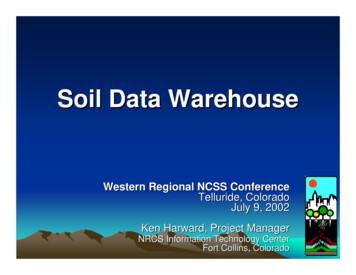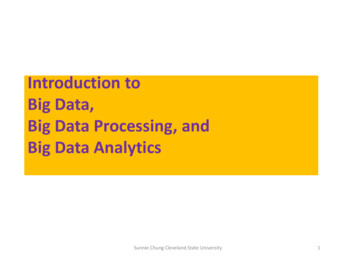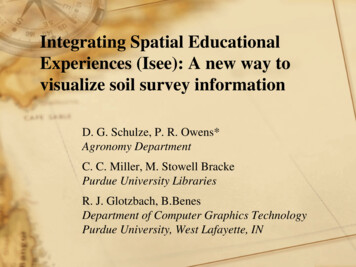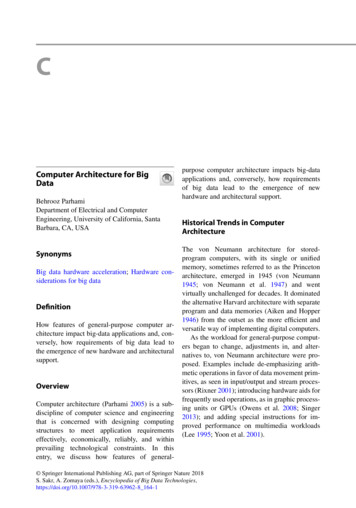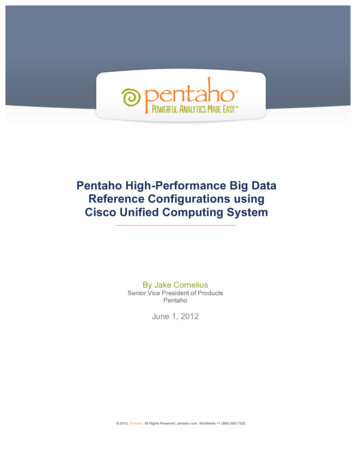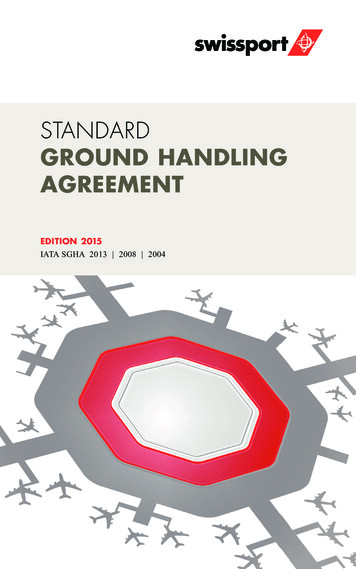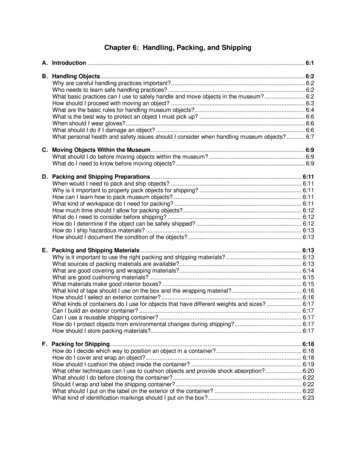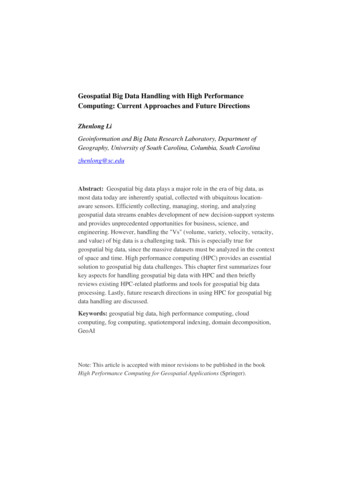
Transcription
Geospatial Big Data Handling with High PerformanceComputing: Current Approaches and Future DirectionsZhenlong LiGeoinformation and Big Data Research Laboratory, Department ofGeography, University of South Carolina, Columbia, South Carolinazhenlong@sc.eduAbstract: Geospatial big data plays a major role in the era of big data, asmost data today are inherently spatial, collected with ubiquitous locationaware sensors. Efficiently collecting, managing, storing, and analyzinggeospatial data streams enables development of new decision-support systemsand provides unprecedented opportunities for business, science, andengineering. However, handling the "Vs" (volume, variety, velocity, veracity,and value) of big data is a challenging task. This is especially true forgeospatial big data, since the massive datasets must be analyzed in the contextof space and time. High performance computing (HPC) provides an essentialsolution to geospatial big data challenges. This chapter first summarizes fourkey aspects for handling geospatial big data with HPC and then brieflyreviews existing HPC-related platforms and tools for geospatial big dataprocessing. Lastly, future research directions in using HPC for geospatial bigdata handling are discussed.Keywords: geospatial big data, high performance computing, cloudcomputing, fog computing, spatiotemporal indexing, domain decomposition,GeoAINote: This article is accepted with minor revisions to be published in the bookHigh Performance Computing for Geospatial Applications (Springer).
21. IntroductionHuge quantities of data are being generated across a broad range ofdomains, including banking, marketing, health, telecommunications,homeland security, computer networks, e-commerce, and scientificobservations and simulations. These data are called big data. While thereis no consensus on the definition of big data (Ward and Barker, 2013; DeMauro et al., 2015), one widely used definition is: “datasets whose size isbeyond the ability of typical database software tools to capture, store,manage, and analyze” (Manyika et al., 2011, p.1).Geospatial big data refers to a specific type of big data that containslocation information. Location information plays a significant role in thebig data era, as most data today are inherently spatial, collected withubiquitous location-aware sensors such as satellites, GPS, andenvironmental observations. Geospatial big data offers great opportunitiesfor advancing scientific discoveries across a broad range of fields,including climate science, disaster management, public health, precisionagriculture, and smart cities. However, what matters is not the big dataitself but the ability to efficiently and promptly extract meaningfulinformation from it, an aspect reflected in the widely used big datadefinition provided above. Efficiently extracting such meaningfulinformation and patterns is challenging due to big data’s 5-Vcharacteristics—volume, velocity, variety, veracity, value (Zikopoulos andEaton, 2011; Zikopoulos et al., 2012; Gudivada et al., 2015) —andgeospatial data’s intrinsic feature of space and time. Volume refers to thelarge amounts of data being generated. Velocity indicates the high speed ofdata streams and that accumulation exceeds traditional settings. Varietyrefers to the high heterogeneity of data, such as different data sources,formats, and types. Veracity refers to the uncertainty and poor quality ofdata, including low accuracy, bias, and misinformation. For geospatial bigdata, these four Vs must be handled in the context of dynamic space andtime to extract the ‘value’ from big data, which creates further challenges.High performance computing (HPC) provides an essential solution togeospatial big data challenges by allowing fast processing of massive datacollections in parallel. Handing geospatial big data with HPC can help us
3make quick and better decisions in time-sensitive situations, such asemergency response (Bhangale et al., 2016). It also helps us to solve largerproblems, such as high-resolution global forest cover change mapping inreasonable timeframes (Hansen et al., 2013) and to achieve interactiveanalysis and visualization of big data (Yin et al., 2017).This chapter explores how HPC is used to handle geospatial big data.Section 2 first summarizes four typical sources of geospatial big data.Section 3 describes the four key components, including data storage andmanagement (section 3.1), spatial indexing (section 3.2), domaindecomposition (3.3), and task scheduling (section 3.4). Section 4 brieflyreviews existing HPC-enabled geospatial big data handling platforms andtools, which are summarized into four categories: general-purpose (section4.1), geospatial-oriented (section 4.2), query processing (section 4.3), andworkflow-based (section 4.4). Three future research directions forhandling geospatial big data with HPC are suggested in section 5,including working towards a discrete global grid system (section 5.1), fogcomputing (section 5.2), and geospatial artificial intelligence (section 5.3).Lastly, section 6 summarizes the chapter.2. Sources of Geospatial Big DataFour typical sources of geospatial big data are summarized below. Earth observationsEarth observation systems generate massive volumes of disparate,dynamic, and geographically distributed geospatial data with in-situ andremote sensors. Remote sensing, with its increasingly higher spatial,temporal, and spectral resolutions, is one primary approach for collectingEarth observation data on a global scale. The Landsat archive, forexample, exceeded one petabyte and contained over 5.5 million imagesseveral years ago (Wulder et al., 2016; Camara et al., 2016). As of 2014,NASA’s Earth Observing System Data and Information System (EOSDIS)was managing more than nine petabytes of data, and it is adding about 6.4terabytes to its archives every day (Blumenfeld, 2019). In recent years, thewide use of drone-based remote sensing has opened another channel forbig Earth observation data collection (Athanasis et al., 2018).
4 Geoscience model simulationsThe rapid advancement of computing power allows us to model andsimulate Earth phenomena with increasingly higher spatiotemporalresolution and greater spatiotemporal coverage, producing huge amountsof simulated geospatial data. A typical example is the climate modelsimulations conducted by the Intergovernmental Panel on Climate Change(IPCC). The IPCC Fifth Assessment Report (AR5) alone produced tenpetabytes of simulated climate data, and the next IPCC report is estimatedto produce hundreds of petabytes (Yang et al., 2017; Schnase et al., 2017).Beside simulations, the process of calibrating the geoscience models alsoproduces large amounts of geospatial data, since a model often must be runmany times to sweep different parameters (Murphy et al., 2014). Whencalibrating ModelE (a climate model from NASA), for example, threeterabytes of climate data were generated from 300 model-runs in just oneexperiment (Li et al., 2015). Internet of ThingsThe term Internet of Things (IoT) was first coined by Kevin Ashton in1999 in the context of using radio frequency identification (RFID) forsupply chain management (Ashton, 2009). Simply speaking, the IoTconnects “things” to the internet and allows them to communicate andinteract with one another, forming a vast network of connected things. Thethings include devices and objects such as sensors, cellphones, vehicles,appliances, and medical devices, to name a few. These things, coupledwith now-ubiquitous location-based sensors, are generating massiveamounts of geospatial data. In contrast to Earth observations and modelsimulations that produce structured multi-dimensional geospatial data, IoTcontinuously generates unstructured or semi-structured geospatial datastreams across the globe, which are more dynamic, heterogeneous, andnoisy. Volunteered geographic informationVolunteered geographic information (VGI) refers to the creation anddissemination of geographic information from the public, a process inwhich citizens are regarded as sensors moving “freely” over the surface of
5the Earth (Goodchild, 2017). Enabled by the internet, Web 2.0, GPS, andsmartphone technologies, massive amounts of location-based data arebeing generated and disseminated by billions of citizen sensors inhabitingthe world. Through geotagging (location sharing), for example, socialmedia platforms such as Twitter, Facebook, Instagram, and Flickr provideenvironments for digital interactions among millions of people in thevirtual space while leaving “digital footprints” in the physical space. Forexample, about 500 million tweets are sent per day according to InternetLive Stats (2019); assuming the estimated 1% geotagging rate (Marciniec,2017), five million tweets are geotagged daily.3. Key Components of Geospatial Big Data Handling with HPC3.1 Data storage and managementData storage and management is essential for any data manipulationsystem, and it is especially challenging when handling geospatial big datawith HPC for two reasons. First, the massive volumes of data require largeand reliable data storage. Traditional storage and protective fault-tolerancemechanisms, such as RAID (redundant array of independent disks), cannotefficiently handle data at the petabyte scale (Robinson, 2012). Second, thefast velocity of the data requires storage with flexibility to scale up or outto handle the ever-increasing storage demands (Katal et al., 2013).There are three common types of data storage paradigms in HPC: sharedeverything architecture (SEA), shared-disk architecture (SDA), andshared-nothing architecture (SNA) (Figure 1). With SEA, data storage andprocessing are often backed by a single high-end computer. Theparallelization is typically achieved with multi-cores or graphicsprocessing units (GPUs) accessing data from local disks. The storage ofSEA is limited to a single computer and thus cannot efficiently handle bigdata.SDA is a traditional HPC data storage architecture that stores data in ashared system that can be accessed by a cluster of computers in parallelover the network. Coupled with the message passing interface (MPI)(Gropp et al., 1996), the SDA-based HPC enables data to be transferredfrom storage to the compute nodes and processed in parallel. Most
6computing-intensive geospatial applications used it prior to the big dataera. However, SDA does not work well with big data, as transferring largeamounts of data over the network quickly creates a bottleneck in thesystem (Yin et al., 2013). In addition, the shared disk is prone to becomethe single point failure of the system.Shared-nothing architecture (SNA) is not a new paradigm. Stonebrakerpointed out in 1986 that shared-nothing was a preferred approach indeveloping multiprocessor systems at that time. With SNA, the data aredistributedly stored on the cluster computers, each locally storing a subsetof the data. SNA has become the de facto big data storage architecturenowadays because: (1) it is scalable, as new compute nodes can be easilyadded to an HPC cluster to increase its storage and computing capacity, (2)each data subset can be processed locally by the computer storing it,significantly reducing data transmission over the network, and (3) thesingle point failure is eliminated since the computers are independent andshare no centralized storage.Figure 1. Illustration of different data storage architectures in HPC systemsOne popular implementation of SNA is the Hadoop Distributed FileSystem (HDFS) (Shvachko et al., 2010) —the core storage system for theHadoop ecosystem. HDFS splits data into blocks and stores them acrossdifferent compute nodes in a Hadoop cluster, so they can be processed inparallel. Like HDFS, most NoSQL (not only SQL) databases—includingHBase (Vora, 2011), MongoDB (Abramova and Bernardino, 2013), andGoogle BigTable (Chang et al., 2008)—adopt SNA to store and managebig unstructured or semi-structured data. Since HDFS and NoSQLdatabases are not designed to store and manage geospatial data, many
7studies have been conducted to modify or extend these systems byintegrating the spatial dimension (e.g., Wang et al., 2013; Zhang et al.,2014; Eldawy and Mokbel, 2015). Because the access patterns of ageospatial data partition (or block) are strongly linked to its neighboringpartitions, co-locating the partitions that are spatially close with each otherto a same computer node often improves data access efficiency in SNA(Fahmy, Elghandour, Nagi, 2016; Baumann et al., 2018).3.2 Spatial indexingWith HPC, many processing units must concurrently retrieve differentpieces of the data to perform various data processing and spatial analysisin parallel (e.g., clipping, road network analysis, remote sensing imageclassification). Spatial indexing is used to quickly locate and access theneeded data, such as specific image tiles for raster data or specificgeometries for vector data, from a massive dataset. Since the performanceof the spatial index determines the efficiency of concurrent spatial datavisits (Zhao et al., 2016), it directly impacts the performance of paralleldata processing.Most spatial indexes are based on tree data structures, such as the quadtree(Samet 1984), KD-tree (Ooi, 1987), R-tree (Guttman, 1984), and theirvariants. Quadtree recursively divides a two-dimensional space into fourquadrants based on the maximum data capacity of each leaf cell (e.g., themaximum number of points allowed). A KD-tree is a binary tree oftenused for efficient nearest-neighbor search. An R-tree is similar to a KDtree, but it handles not only point data but also rectangles such as geometrybounding boxes. As a result, R-trees and their variants have been widelyused for spatial indexing (e.g., Xia et al., 2014; Wang et al., 2013).Especially focusing on geospatial big data, He et al. (2015) introduced aspatiotemporal indexing method based on decomposition tree raster dataindexing for parallel access of big multidimensional movement data.SpatialHadoop uses an R-tree-based, two-level (global and local) spatialindexing mechanism to manage vector data (Eldawy and Mokbel, 2015)and a quadtree-based approach to index raster data (Eldawy et al., 2015).
8The ability to store and process big data in its native formats is importantbecause converting vast amounts of data to other formats requires effortand time. However, most indexing approaches for handling geospatial bigdata in an HPC environment (such as Hadoop) require data conversion orpreprocessing. To tackle this challenge, Li et al. (2017) proposed aspatiotemporal indexing approach (SIA) to store and manage massiveclimate datasets in HDFS in their native formats (Figure 2). By linking thephysical location information of node, file, and byte to the logicalspatiotemporal information of variable, time, and space, a specific climatevariable at a specific time, for example, can be quickly located andretrieved from terabytes of climate data at the byte level. The SIAapproach has been extended to support other array-based datasets anddistributed computing systems. For example, it was adopted by theNational Aeronautics and Space Administration (NASA) as one of the keytechnologies in its Data Analytics and Storage System (DAAS) (Duffy etal., 2016). Based on SIA, Fu et al. (2018) developed an in-memorydistributed computing framework for big climate data using Apache Spark(Zaharia et al., 2016). Following a concept similar to SIA, Li et al. (2018)developed a tile-based spatial index to handle large-scale LiDAR (lightdetection and ranging) point-cloud data in HDFS in their native LASformats.Figure 2. Illustration of the spatiotemporal indexing approach (Li et al.,2017)3.3 Domain decomposition
9Taking a divide-and-conquer approach, HPC first divides a big probleminto concurrent small problems and then process them in parallel usingmultiple processing units (Ding and Densham, 1996). This procedure iscalled decomposition. Based on the problem to be solved, thedecomposition will take one of three forms: domain decomposition,function decomposition, or both. Domain decomposition treats the data tobe processed as the problem and decomposes them into many smalldatasets. Parallel operations are then performed on the decomposed data.Function decomposition, on the other hand, focuses on the computation,dividing the big computation problem (e.g., a climate simulation model)into small ones (e.g., ocean model, atmospheric model). We focus ondomain decomposition here, as it is the typical approach used forprocessing geospatial big data with HPC.Geospatial data, regardless of source or type, can be abstracted as a fivedimensional (5D) tuple X, Y, Z, T, V , where X, Y, Z denotes a locationin three dimensional space, T denotes time, and V denotes a variable(spatial phenomenon), such as the land surface temperature observed atlocation X, Y, Z and time T. If a dimension has only one value, it is set to1 in the tuple. For example, NASA’s Modern-Era Retrospective analysisfor Research and Applications (MERRA) hourly land surface data can berepresented as X, Y, 1, T, V since there are no vertical layers. Based onthis abstraction, domain decomposition can be applied to differentdimensions of the data, resulting in different decompositions, such as 1Ddecomposition, 2D decomposition, and so on (Figure 3). The total numberof subdomains produced by a domain decomposition equals the product ofthe number of slices of each domain.
10Figure 3. Illustration of domain decomposition. (a) 1D decomposition,decomposing any dimension of X, Y, Z, T, V ; (b) 2D decomposition,decomposing any two dimensions of X, Y, Z, T, V ; (c) 3Ddecomposition, decomposing any three dimensions of X, Y, Z, T, V .Spatial decomposition occurs when data along the spatial dimensions X,Y, Z are decomposed. 2D spatial decomposition along X, Y oftenutilizes the regular grid or a quadtree-based approach, though irregulardecomposition has also been used (Widlund, 2009; Guan, 2009). Wangand Armstrong (2003), for example, developed a parallel inverse-distanceweighted (IDW) spatial interpolation algorithm in an HPC environmentusing a quadtree-based domain decomposition approach. The quadtree wasused to decompose the study area for adaptive load balancing. In a similarapproach described by Guan, Zhang, and Clarke (2006), a spatiallyadaptive decomposition method was used to produce workload-orientedspatially adaptive decompositions. A more recent study by Li, Hodgson,and Li (2018) used a regular grid to divide the study area into many equalsized subdomains for parallel LiDAR data processing. The size of the gridcell is calculated based on the study area size and available computingresources to maximize load balancing. Like 2D spatial decomposition, 3Dspatial decomposition often uses a regular cube or octree-based approachto create 3D subdomains (Tschauner and Salinas, 2006). For example, Liet al. (2013) processed 3D environmental data (dust storm data) in parallelin an integrated GPU and CPU framework by equally dividing the datainto 3D cubes.Temporal decomposition decomposes data along the time dimension,which works well for time series data. Variable decomposition can beapplied when a dataset contains many variables. For instance, MERRAland reanalysis data (MST1NXMLD) contains 50 climate variables thatspan from 1979 to the present with an hourly temporal resolution and aspatial resolution of 2/3 x 1/2 degree (Rienecker et al., 2011). In this case,the decomposition can be applied to the temporal dimension (T), thevariable dimension (V), or both (T, V) (Li et al., 2015; Li et al., 2017).When conducting domain decomposition, we need to consider whetherdependence exists among the subdomains—in other words, whether a
11subdomain must communicate with others. For spatial decomposition, weneed to check whether spatial dependence exists. For example, whenparallelizing the IDW spatial interpolation algorithm using quadtree-basedspatial decomposition, neighboring quads need to be considered (Wangand Armstrong, 2003). For some other operations, such as rasterizingLiDAR points, each subdomain can be processed independently withoutcommunicating with others (Li et al., 2018). For temporal decomposition,temporal dependence may need to be considered. For example, to extractthe short- or long-term patterns from time series data requires consideringtemporal dependences in the decomposition (Asadi and Regan, 2019).Conversely, computing the global annual mean of an hourly climatevariable does not require such consideration.Knowing whether to consider dependence when decomposing data helpsus design more efficient decomposition methods because avoidingunnecessary communications among subdomains often leads to betterperformance (Li et al., 2018). The problem of spatial dependence can besolved in multiple ways as summarized in Zheng et al., (2018). Spatial andtemporal buffering can be used in domain decomposition to preventcommunication with neighboring subdomains. For example, Hohl,Delmelle, and Tang (2015) used spatiotemporal buffers to include adjacentdata points when parallelizing the kernel density analysis.In addition to spatiotemporal dependence, the distribution of underlyingdata also needs special consideration for spatial and spatiotemporal domaindecomposition because different data might pose different requirementsfor decomposition. For instance, while Hohl et al. (2018) decompose datathat are distributed irregularly in all three dimensions, the data inDesjardins et al. (2018) are distributed irregularly in space, but regularly intime. As a result, different decomposition methods are used in the twoexamples for optimized performance.3.4 Task schedulingTask scheduling refers to distributing subtasks (subdomains) to concurrentcomputing units (e.g., CPU cores or computers) to be processed in parallel.Task scheduling is essential in HPC because the time spent to finish
12subtasks has a direct impact on parallelization performance. Determiningan effective task schedule depends on the HPC programming paradigmsand platforms (e.g., MPI-based or Hadoop-based), the problems to beparallelized (e.g., data-intensive or computation-intensive), and theunderlying computing resources (e.g., on-premise HPC cluster or ondemand cloud-based HPC cluster). Regardless, two significant aspectsmust be considered to design efficient task scheduling approaches forgeospatial big data processing: load balancing and data locality.Load balancing aims to ensure each computing unit receives a similar (ifnot identical) number of subtasks for a data processing job, so that eachfinishes at the same time. This is important because in parallel computing,the job’s finishing time is determined by the last finished task. Therefore,the number of subdomains and the workload of each should be consideredalong with the number of available concurrent computing units for loadbalancing. A load balancing algorithm can use static scheduling that eitherpre-allocates or adaptively allocates tasks to each computing unit (Guan,2009; Shook et al., 2016). For example, Wang and Armstrong (2003)scheduled tasks based on the variability of the computing capacity at eachcomputing site and the number of workloads used to partition the problemin a grid computing environment.While most big data processing platforms (such as Hadoop) have built-inload balancing mechanisms, they are not efficient when processinggeospatial big data. Hadoop-based geospatial big data platforms, such asGeoSpark (Yu, Wu, and Sarwat, 2015) and SpatialHadoop (Eldawy andMokbel, 2015), often provide customized load balancing mechanisms thatconsider the nature of spatial data. For example, Li et al. (2017) used a gridassignment algorithm and a grid combination algorithm to ensure eachcompute node received a balanced workload when processing big climatedata using Hadoop. When processing big LiDAR data, Li et al. (2018)calculated the number of subdomains to be decomposed based on the datavolume and number of compute nodes in a cluster. In all cases, thesubdomains should be comparably sized to better balance the load. In acloud-based HPC environment, load balancing can also be achieved by
13automatically provisioning computing resources (e.g., add more computenodes) based on the dynamic workload (Li et al., 2016).Data locality refers to how close data are to their processing locations; ashorter distance indicates better data locality (Unat et al., 2017). Good datalocality requires less data movement during parallel data processing andthus leads to better performance. Discussing data locality makes littlesense in traditional HPC since it uses shared-disk architecture (section2.1). A shared-disk architecture separates compute nodes and storage, thusrequiring data movement. However, data locality is important forgeospatial big data processing (Guo, Fox, and Zhou, 2012) because bigdata platforms (e.g., Hadoop) use shared-nothing storage; moving massivedata among the compute nodes over the network is costly.To archive data locality, the task scheduler is responsible for assigning asubdomain (data subset) to the compute node where the subdomain islocated or stored. Thus, the task scheduler must know a subdomain’sstorage location, which can be realized by building an index to link datalocation in the cluster space to other spaces—geographic, variable, and filespaces. For instance, with a spatiotemporal index recording of the computenode on which a climate variable is stored, 99% of the data grids can beassigned to the compute nodes where the grids are stored, significantlyimproving performance (Li et al., 2017). In a LiDAR data processing study(Li et al., 2018), a spatial index was used to record a data tile’s location inboth the cluster and geographic spaces. Each subdomain was then assignedto the node where most of the tiles were stored. It is worth noting thatbesides load balancing and data locality, other factors such as computingand communication costs should also be considered for task scheduling.4. Existing Platforms for Geospatial Big Data Handling with HPCThere are many existing platforms for handling geospatial big data withHPC. These offer various programming models and languages, softwarelibraries, and application programming interfaces (APIs). Here I brieflyreview some of the popular platforms by summarizing them into fourgeneral categories.4.1 General-purpose platforms
14General-purpose parallel programming platforms are designed to handledata from different domains. Open MPI, for example, is an open sourceMPI implementation for traditional HPC systems (Gabriel et al., 2004).Another open source HPC software framework is HTCondor (known asCondor before 2012), which supports both MPI and Parallel VirtualMachine (Thain, Tannenbaum, and Livny, 2005). Different from OpenMPI and HTCondor, CUDA is a parallel computing platform designed toharness the power of the graphics processing unit (GPU) (Nvidia, 2011).GPU has a transformative impact on big data handling. A good example ofhow GPU enables big data analytics in the geospatial domain can be foundin Tang, Feng and Jia (2015).Entering the big data world, Hadoop, an open source platform, is designedto handle big data using a shared-nothing architecture consisting ofcommodity computers (Taylor, 2010). With Hadoop, big data is stored inthe Hadoop distributed files system (HDFS) and is processed in parallelusing the MapReduce programming model introduced by Google (Deanand Ghemawat, 2008). However, Hadoop is a batch processing frameworkwith high latency and does not support real-time data processing. ApacheSpark, an in-memory distributed computing platform using the sameshared-nothing architecture as Hadoop, overcomes some of Hadoop’slimitations (Zaharia et al., 2016).4.2 Geospatial-oriented platformsAs general-purpose platforms are not designed for handling geospatialdata, efforts have been made to adapt existing parallel libraries orframeworks for them. Domain decomposition, spatial indexing, and taskscheduling are often given special considerations when buildinggeospatial-oriented programming libraries. One outstanding early work isGISolve Toolkit (Wang, 2008), which aims to enhance large geospatialproblem-solving by integrating HPC, data management, and visualizationin cyber-enabled geographic information systems (CyberGIS) environment(Wang, 2010; Wang et al., 2013). Later, Guan (2009) introduced an opensource general-purpose parallel-raster-processing C library using MPI.More recently, Shook et al. (2016) developed a Python-based library for
15multi-core parallel processing of spatial data using a parallel cartographicmodeling language (PCML).In the big data landscape, an array of open source geospatial platforms hasbeen developed based on Hadoop or Hadoop-like distributed computingplatforms, including, for example, HadoopGIS (Wang et al., 2011),Geotrellis (Kini and Emanuele, 2014), SpatialHadoop (Eldawy andMokbel, 2015), GeoSpark (Yu, Wu, and Sarwat 2015), GeoMesa (Hugheset al., 2015), EarthServer (Baumann et al., 2016), GeoWave (Whitby,Fecher and Bennight, 2017), and St Hadoop (Alarabi, Mokbel, andMusleh, 2018). While not open source, Google Earth Engine (Gorelick etal., 2017) is a powerful and planetary-scale geospatial big data platform forparallel processing and analysis of petabytes of satellite imagery and othergeospatial datasets.4.3 Query processingMost general-purpose and geospatial-oriented programming libraries allowusers to develop parallel data processing programs based on the APIs.Computer programming or scripting is generally needed, though someplatforms offer high-level interfaces to ease development. Queryprocessing falls into another category of big data processing that leveragesstructured query language for programming. Query processing, especiallySQL-based, has gained noticeable popularity in the big data era, partl
Geospatial big data refers to a specific type of big data that contains location information. Location information plays a significant role in the big data era, as most data today are inherently spatial, collected with ubiquitous location-aware sensors
